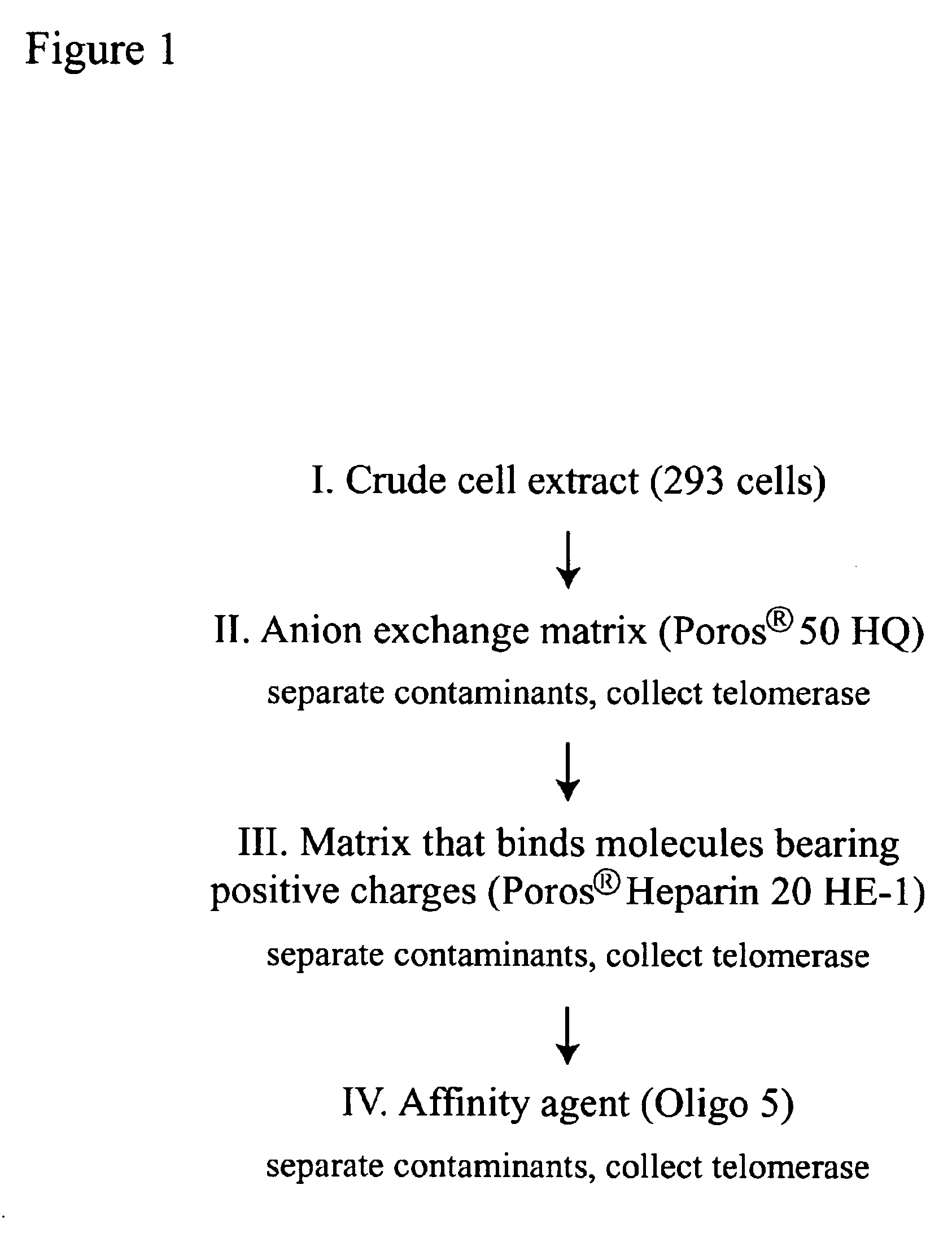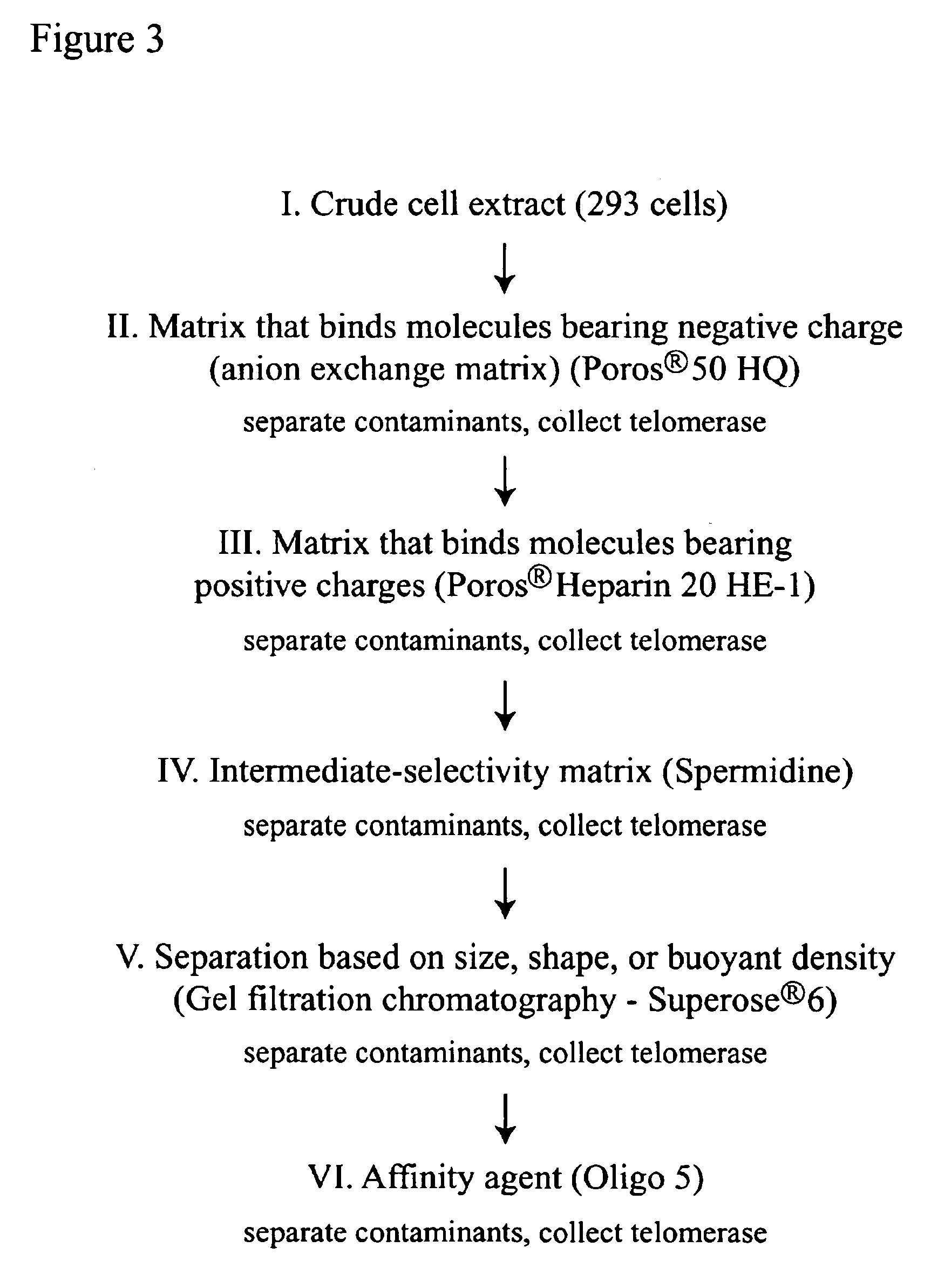Producing telomerase activators and inhibitors by screening with purified telomerase
a technology of purified telomerase and activator, which is applied in the direction of biocide, transferase, antibody medical ingredients, etc., can solve the problems of shortening, cell division no longer possible, and purification of human enzymes posed technical challenges
- Summary
- Abstract
- Description
- Claims
- Application Information
AI Technical Summary
Benefits of technology
Problems solved by technology
Method used
Image
Examples
example i
Telomerase Assay Protocols
A. Primer Elongation Assay
[0069]a) Assay
[0070]The primer elongation assay described in this example is the standard for determining specific activity for the purposes of determining relative purity of a telomerase preparation.
[0071]The 40 μl telomerase reaction should have a final concentration of:[0072]1. 1X Telomerase Buffer (see below)[0073]2. 1 mM MgCl2 [0074]3. 2 mM DATP, 2 mM dTTP, 8 μM dGTP[0075]4. 1 μM or 0.25 μg / reaction of oligo primer M2 / TS[0076]5. 20 μCi / reaction of (α32P-dGTP (0.624 μM dGTP, spec. activity 800 Ci / mmol; NEN)[0077]1. To start the reaction, combine 20 μl of the 2× reaction mix with an equal volume (20 μl) of enzyme extract.[0078]For RNase control, add 1 μl of RNase A at 5 mg / mL to buffer mix just before adding extract.[0079](Final concentration of RNase is 125 μg / mL)[0080]2. Incubate at 30° C. for 90 min (total volume=40 μl).[0081]3. To stop reaction, add 50 μl of TE stop solution (10 mM Tris pH 7.5 and 20 mM EDTA) containing 100 ...
example ii
Protocols for Crude Cell Extract from 293 Cells
[0168]This preparation prefers a minimum of 107 cells, either suspension or adherent cells. It can be scaled up for larger numbers of cells proportionally. Preparation of as much as 7.7×1010 cells has been done with excellent activity but slightly higher background. Furthermore, the whole procedure should be performed at 4° C. and on ice.
[0169]Grow cells to midlog phase. Adequate additional cells for counting should be provided: the calculation of buffer amounts is dependent on the number of cells rather than volume.
[0170]Either CHAPS or CHAPSO detergent can be used. These show little differences in obtaining active extracts.
A. Buffers
Wash Buffer
[0171]
StockFinal20 mL100 mL1 M HEPES pH 7.510 mM200λ1 mL1 M MgCl21.5 mM 30λ150λ1 M KCl10 mM200λ1 mL1 M DTT 1 mM 20λ100λDEPC H2O19.55 mL97.75 mL
Lysis Buffer (0.5% CHAPS / CHAPSO)
[0172]
StockFinal10 mL50 mL60 mL 1 M Tris Cl pH 7.510 mM 100λ 500μl600μl 1 M MgCl21 mM10λ50μl60μl0.5 M EGTA1 mM20λ10...
example iii
Four Step Method for Purifying Telomerase
[0181]A method of making human telomerase that is 3,550-fold purified compared to that in crude cell extracts is described. This method comprises four steps in succession:
[0182]1) CHAPS detergent S-100 extract preparation from 293 cells;
[0183]2) chromatography of the S-100 extract on POROS® 500 HQ matrix;
[0184]3) chromatography of the POROS® 50 HQ active fractions on POROS® 20 Heparin HE-1 matrix; and 4) chromatography of the POROS® 20 Heparin HE-1 active fractions on Oligo 5 affinity matrix. Protocols for each step are provided.
[0185]In the first step, 7.3×1010 293 cells were collected from 128 liters of suspension culture and CHAPS extracted as described in Example II to yield 883 mL of CHAPS S-100 extract.
[0186]In the second step, this extract was subjected to chromatography on a POROS® 50 HQ column, and fractions containing telomerase activity were combined for a total active pool of 72 mL. This step was performed as follows:
[0187]POROS® ...
PUM
| Property | Measurement | Unit |
|---|---|---|
| molecular weight | aaaaa | aaaaa |
| concentrations | aaaaa | aaaaa |
| ionic strength | aaaaa | aaaaa |
Abstract
Description
Claims
Application Information
 Login to View More
Login to View More - R&D
- Intellectual Property
- Life Sciences
- Materials
- Tech Scout
- Unparalleled Data Quality
- Higher Quality Content
- 60% Fewer Hallucinations
Browse by: Latest US Patents, China's latest patents, Technical Efficacy Thesaurus, Application Domain, Technology Topic, Popular Technical Reports.
© 2025 PatSnap. All rights reserved.Legal|Privacy policy|Modern Slavery Act Transparency Statement|Sitemap|About US| Contact US: help@patsnap.com



